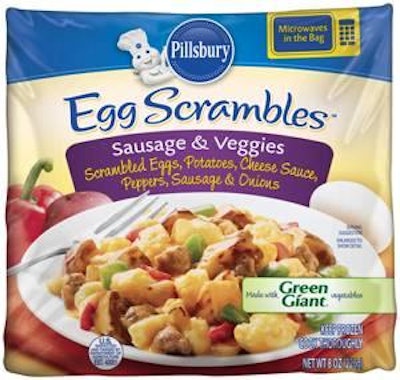
There has been a change in the reason why eggs are included as an ingredient in food products, according to Peeyush Maheshwari, who has 17 years of experience working in research and development for General Mills. He told the audience at the International Egg Commission meeting in London that 10 years ago most companies put eggs in food products for a functional reason, but that today they are using eggs as an ingredient for nutritional reasons.
Research studies have shown that people who eat eggs benefit from an increased feeling of satiety while eating eggs also helps to reduce their total calorie consumption. With concerns about obesity in the U.S. and in some other developed countries, this attribute has become attractive to both consumers and product developers.
No. 1 breakfast ingredient
Eggs are a good source of vitamins, high-quality protein and calories. “Eggs are the gold standard of protein; every single protein content and usage claim is verified versus egg quality,” Maheshwari said.
“Kashi is touting their cereal in relation to the protein found in an egg,” he said. While some may see a cereal company comparing its products to eggs as having a negative impact on egg sales, Maheshwari sees it as an affirmation of all of the positive nutritional aspects of eggs. “In my view, there is much more positive going on with eggs as an ingredient than there are negatives,” he said. “Eggs are the No. 1 breakfast ingredient; they are very versatile.”
Additional health benefits
The health benefits of egg and egg products beyond the basic nutrition, high-quality protein, easily digestible nutrients, etc., are emerging at a fast rate, according to Maheshwari. He said consumer research shows that omega-3 fatty acid and vitamins and minerals claims are gaining in popularity. He predicted that cholesterol minimization will continue to receive more attention in order to attract health-conscious consumers. Currently, organic, allergy-free and natural claims are the most dominant passive health positioning for food products.
He said that they are noticing an increased focus on the hen’s feed as an influencing factor on egg quality, taste and nutritional benefits.
New egg products
Maheshwari characterized the worldwide introductions of new products with eggs as having a slow rate of growth. In the two years starting January of 2010 and ending December of 2011, he said that more than 800 egg-related product launches were recorded on the Innova database. Asia had the highest percentage growth rate for new products containing eggs, but Europe had more than 50 percent of the total new egg product launches.
When a consumer makes the decision to try a new food product, factors such as convenience, better value, health and nutrition, and food trends are all important, but Maheshwari said that taste is still king.
When you consider using things like cage-free or free-range eggs as an ingredient, he said that the supply chain availability of these eggs becomes an important factor. “What is the outlook for the supply of these products and what will be the long-term availability?” he asked. Maheshwari cautioned that for some consumers the ability to make claims like natural or cage free is very important, but you need to make sure the group of consumers you are targeting with your product are consumers who are really interested in that claim.
If you are using egg as a finished product or if you are using egg as an ingredient, there are some different things to consider, according Maheshwari. He said that price volatility and supply chain availability are very important when considering using eggs as an ingredient in a food product, particularly in the developing world.
“Concerns about sustainability, supply and quality are becoming a major piece whenever we are launching a product with egg either as an ingredient or a finished product,” he said. “When considering egg as an ingredient the cost of alternatives is important.”
Hard as it is to believe, Maheshwari said that not everyone likes eggs. For these consumers, using eggs as an ingredient is the only way to reach them. Breakfast items like waffles, pancakes and many baked goods provide an opportunity to get eggs into the diets of consumers who aren’t thrilled with a “sunny side up” breakfast.
When using eggs as the finished product, “homemade taste is the key,” he said. “Chickens lay eggs not patties. You want to give the consumer a finished product that looks and tastes like it would at home. The homemade experience is really the key.”
New products from Pillsbury
Pillsbury is a division of General Mills, and Maheshwari described two new Pillsbury product lines that feature eggs. He said that Pillsbury wants to present a good, easy, real no-fuss meal to the consumer. “Real food in a familiar form, minimal effort in cleaning, minimal mess and minimal time,” he said.
Both Pillsbury Egg Scrambles and Pillsbury Grands! Biscuit Sandwiches use scrambled eggs as the star attraction. Maheshwari said that scrambled eggs are more like what the consumer might make at home and are not a “patty” of egg. To help provide a feeling of satiety to the consumer and to attract health conscious consumers, he said that it is also important to try and include vegetables as an ingredient in these products.
Pillsbury Egg Scrambles have eggs, vegetables, cheese and meat frozen all together in a microwavable pouch. Maheshwari said that the pouch cooks everything properly without the need for a pan or spatula. Many consumers cite having to wash dishes as a reason they don’t prepare eggs more often at home. He also said that one of the big hurdles with this product line was getting consumers to accept that they can have a high-quality egg product that is frozen.
Maheshwari said that another hurdle has been getting some consumers to understand that the microwave really is the best way to heat the product prior to serving; it works better than heating the product up in a frying pan. Egg Scrambles cook in around six minutes in the microwave.
Pillsbury Grands! Biscuit Sandwiches were developed for the U.S. market, according to Maheshwari, because a handheld breakfast is very popular in the U.S. These sandwiches are stored in the freezer and cook in just 2.5 minutes in the microwave. Three varieties of biscuit sandwiches are available; Ham and Veggies, Bacon and Cheese, and Sausage and Cheese.


















